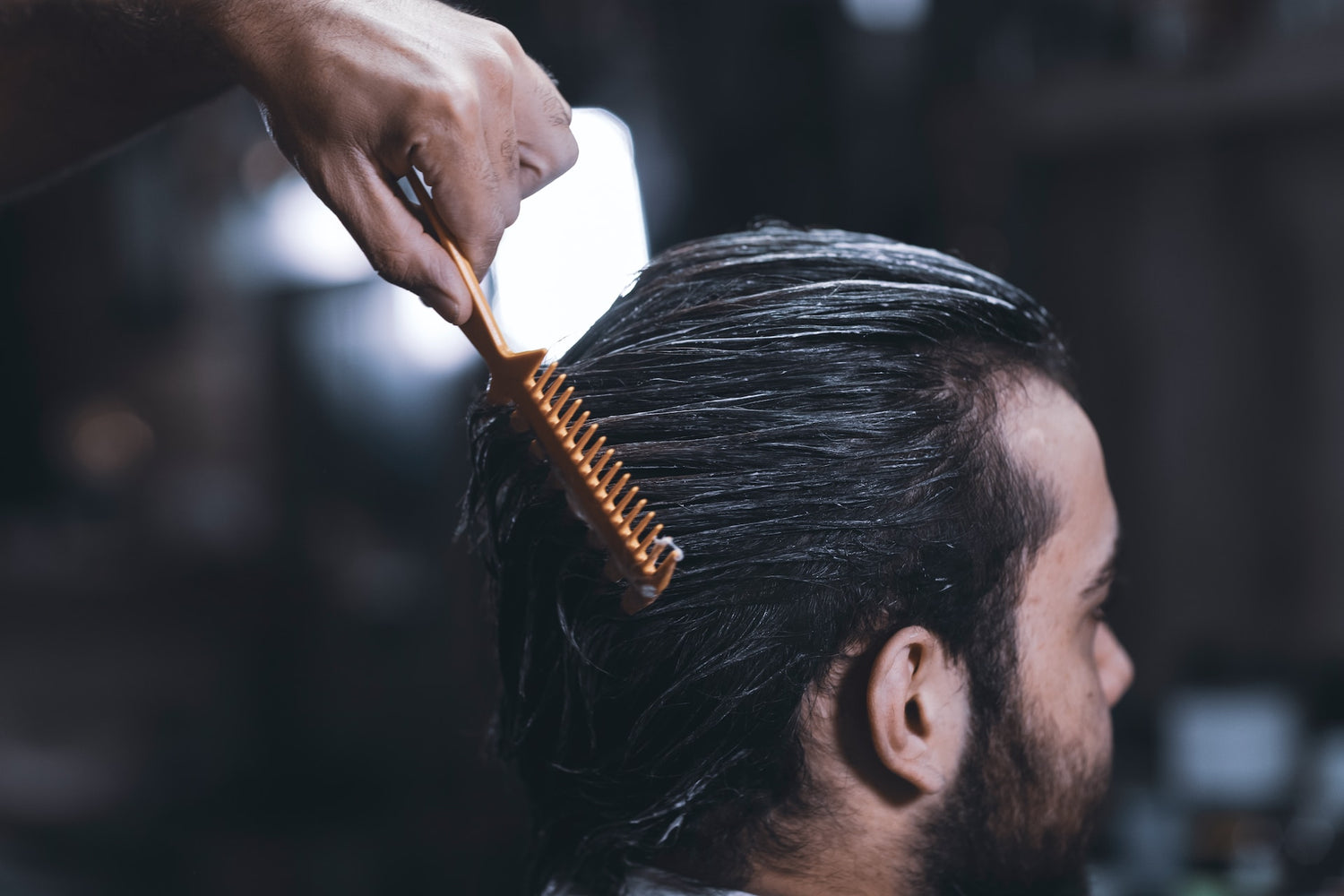Hair loss, medically termed alopecia, is a common issue that many people face, and it can have a big impact on how we feel about ourselves. In the effort to combat hair loss, two popular solutions are available: Minoxidil, a well-known option that's been around for a long time, and RU58841, a newer alternative that's gaining attention.
In this blog, we are here to help you make an informed decision based on your needs. We'll talk about both Minoxidil and RU58841 including what they are, how they work, and what might be the right choice for you. The goal is simple, to provide you with the information you need to decide which path might help you regain a fuller head of hair.
Hair Loss | Symptoms and Causes
Hair loss, or alopecia, is a condition that can impact the scalp or the entire body, and it may be temporary or permanent. The causes of hair loss can vary, including factors such as heredity, hormonal changes, medical conditions, or simply a natural part of the aging process. While anyone can experience hair loss, it is more commonly observed in men.
The term "baldness" typically refers to significant hair loss from the scalp. There are treatment options available for those looking to prevent further hair loss or stimulate new growth.
Before considering any hair loss treatment, it is advisable to consult with a doctor to determine the specific cause of hair loss and explore appropriate treatment options.
Symptoms of Hair Loss
Common signs of hair loss include gradual thinning on the top of the head, a prevalent occurrence associated with aging. In men, hair often recedes at the hairline, while women may experience a broadening of the hair part. Frontal fibrosing alopecia, characterized by a receding hairline in older women, is becoming increasingly common.
- Circular or patchy bald spots are another manifestation of hair loss, affecting the scalp, beard, or eyebrows. It may be accompanied by itching or pain before hair loss occurs.
- Sudden loosening of hair, often triggered by physical or emotional shocks, can lead to temporary overall thinning.
- Additionally, certain conditions or medical treatments like chemotherapy may result in full-body hair loss, with the hair typically regrowing after treatment.
- Scalp issues, such as patches of scaling indicative of ringworm, may also contribute to hair loss, accompanied by broken hair, redness, swelling, and sometimes oozing.
For women experiencing frontal fibrosing alopecia, early treatment discussion with a doctor is very important to prevent significant permanent baldness.
Causes of Hair Loss
People typically shed 50 to 100 hairs daily, usually unnoticed as new hair replaces the fallen ones. However, hair loss becomes evident when the new hair doesn't adequately replace the lost strands. Several factors contribute to hair loss:
Family History (Heredity):
- The most common cause is hereditary conditions associated with aging.
- Known as androgenic alopecia, it presents as male-pattern baldness and female-pattern baldness.
- Gradual and predictable patterns include a receding hairline and bald spots in men and thinning hair along the crown in women.
Hormonal Changes and Medical Conditions:
- Various conditions can lead to permanent or temporary hair loss.
- Hormonal changes due to pregnancy, childbirth, menopause, and thyroid issues are potential causes.
- Medical conditions encompass immune system-related alopecia areata, resulting in patchy hair loss, scalp infections like ringworm, and trichotillomania—a hair-pulling disorder.
Medications and Supplements:
- Certain drugs, including those for cancer, arthritis, depression, heart problems, gout, and high blood pressure, can induce hair loss.
Radiation Therapy to the Head:
- Hair may not grow back the same after undergoing head radiation therapy.
Very Stressful Events:
- General thinning of hair often occurs a few months after experiencing a physical or emotional shock, but this type of hair loss is typically temporary.
Hairstyles and Treatments
Excessive hairstyling or tight hairstyles like pigtails or cornrows can cause traction alopecia, a type of hair loss. Hot-oil hair treatments may also contribute to hair loss, and scarring may result in permanent hair loss.
Hair Loss Diagnosis and Treatments
To diagnose the cause of hair loss, your doctor will conduct a thorough examination and inquire about various aspects, including your diet, hair care practices, and medical and family history. Several diagnostic tests may be recommended:
Blood Test: A blood test can reveal underlying medical conditions that may be contributing to hair loss.
Pull Test: In this test, your doctor gently pulls several dozen hairs to assess the number that comes out. This helps determine the stage of the shedding process.
Scalp Biopsy: Your doctor may perform a scalp biopsy by scraping samples from the skin or plucking a few hairs from the scalp. These samples are then examined under a microscope to identify whether an infection is causing the hair loss.
Light Microscopy: Using a specialized instrument, your doctor examines hairs trimmed at their bases. This microscopy aids in uncovering potential disorders of the hair shaft.
Hair Loss Treatment Options: Effective treatments exist for various types of hair loss, offering possibilities to reverse or, at the very least, slow down the process. Treatment approaches range from medications to surgical interventions.
Medications
Minoxidil (Rogaine)
Available over-the-counter in liquid, foam, and shampoo forms, minoxidil is applied to the scalp once daily for women and twice daily for men. It can help regrow hair and slow the rate of hair loss. Continuous use is required for sustained benefits, and results may take several months to become noticeable.
Finasteride (Propecia)
A prescription drug for men, finasteride is taken daily as a pill. It may slow hair loss and promote new growth in some men. Results become apparent after a few months, and continued use is necessary for lasting benefits. Some rare side effects include diminished sex drive and an increased risk of prostate cancer.
RU-58841
RU-58841 is a nonsteroidal antiandrogen (NSAA) initially developed in the 1970s to address prostate cancer. While it did not prove effective for its intended purpose, users observed increased hair growth in the targeted region.
Other Medications
Spironolactone (Carospir, Aldactone) and Oral Dutasteride (Avodart): These are additional oral options for hair loss treatment.
Note: it's essential to consult with a healthcare professional to determine the underlying cause of hair loss and explore suitable treatment options.
Minoxidil - The Traditional Solution
Minoxidil has been a steadfast ally in the battle against hair loss since the 1970s! Originally developed as a medication to treat high blood pressure, its unexpected side effect of promoting hair growth became a breakthrough discovery. The U.S. Food and Drug Administration (FDA) later approved a topical form of Minoxidil for treating hair loss.
How Minoxidil Works to Promote Hair Growth
The secret behind Minoxidil lies in its ability to enhance blood flow to the hair follicles. When applied topically, it widens the blood vessels and allows more oxygen, blood, and nutrients to reach the hair roots. This increased nourishment can stimulate dormant hair follicles, encouraging them to enter the active growth phase.
In simpler terms, Minoxidil acts like a boost button for your hair follicles and provide them with the extra fuel they need to sprout new strands. It doesn't miraculously create hair where none existed, but it can help existing follicles produce thicker and longer hair.
The Effectiveness of 5% Minoxidil in Treating Hair Loss
Two recent studies examined the impact of 5% minoxidil in treating male-pattern hair loss. Minoxidil, available as Rogaine®, is a topical solution used for hair restoration. The studies, funded by Pfizer Group, assessed its effectiveness and safety in post-marketing conditions in Germany.
In order to ensure safety and efficacy of a drug in a larger patient population, post-marketing studies are necessary. These studies revealed that 5% minoxidil:
- Led to rapid hair growth onset.
- Showed effective results in promoting new hair growth over the treatment period.
- Reduced hair loss significantly.
- Had minimal side effects.
The studies involved 984 men in a 1-year observational study and 743 men in a 4-month surveillance study. Results indicated that a majority experienced smaller balding areas, improved hair density, and satisfaction with treatment. Skin-related side effects were reported by a small percentage, with none classified as serious.
These findings support earlier research on minoxidil's efficacy and safety. While the solution benefits many, individual responses and hair loss progression vary. When consulting a physician hair restoration specialist who can customize treatment plans according to diagnosis and assessment, you are more likely to achieve optimal results. Minoxidil's effectiveness can be enhanced when combined with finasteride and is compatible with hair restoration surgery. (Source)
Minoxidil Side Effects
Minoxidil, while generally well-tolerated, may lead to some side effects, and it's essential to be aware of them:
Common Side Effects:
- Burning, stinging, or redness at the application site are common occurrences. Should these effects persist or worsen, consulting with a healthcare professional is advisable.
Assessment of Risks and Benefits:
- Users should recognize that their doctor has prescribed this medication after evaluating that the benefits outweigh potential risks. Many individuals experience this treatment without encountering serious side effects.
Rare Side Effects:
- In rare cases, absorption through the skin may lead to more severe effects. Cease usage and notify your doctor immediately if you observe unwanted facial/body hair, dizziness, fast/irregular heartbeat, fainting, chest pain, swelling of hands/feet, unusual weight gain, fatigue, or difficulty breathing, particularly when lying down.
Allergic Reactions:
- Although very uncommon, a serious allergic reaction may occur. Seek immediate medical attention if symptoms such as rash, itching/swelling (especially of the face/tongue/throat), severe dizziness, or trouble breathing manifest.
Note: The provided information does not encompass all potential side effects. Any unlisted effects or concerns should be reported to your doctor or pharmacist promptly.

RU58841 - The New Contender
RU58841 represents a more recent addition to the array of options for hair loss. Unlike Minoxidil, RU58841 is a topical anti-androgen, meaning it operates by targeting and counteracting the effects of androgens, which are hormones associated with hair loss.
The mechanism of RU58841 involves inhibiting the binding of dihydrotestosterone (DHT) to hair follicles. DHT is a derivative of testosterone and is known to contribute to the shrinking of hair follicles in individuals genetically predisposed to hair loss. RU58841 interrupts the chain of events leading to hair miniaturization.
How it Differs from Traditional Solutions like Minoxidil
Unlike Minoxidil, which primarily focuses on enhancing blood flow to the hair follicles, RU58841 takes a different approach by addressing hormonal factors. While Minoxidil acts as a general booster for existing follicles, RU58841 is more targeted in its attempt to impede the hormonal influences that contribute to hair thinning.
Study Summary: RU58841's Impact on Human Hair Growth
A study led by B. De Brouwer and his team explored how RU58841, a non-steroidal antiandrogen, affects human hair growth. They did this by transplanting scalp samples from men with hair loss onto female nude mice treated with testosterone.
Here's what they did: they kept twenty scalp grafts on the mice for 8 months. The mice were treated with testosterone on the non-grafted area. They split the scalp samples into two groups—one got RU58841, and the other got ethanol (used as a control). They applied these treatments five days a week.
Results showed that the control group had 28 active hair follicles, but only 7% of them started a new hair cycle. On the other hand, the RU58841-treated group had 29 active follicles, and 28% of them started a new cycle. The RU58841-treated group also had significantly higher hair growth rates.
In simple terms, RU58841 seemed to help hair growth in areas affected by balding when tested on these mice. This is good news, suggesting that RU58841 could be promising for treating hair loss caused by hormones. But, remember, more research is needed to be sure.
RU58841 Effectiveness
RU58841 has garnered positive results for many users across various backgrounds. Users have experienced encouraging outcomes and witnessed benefits in hair health. Here are some noteworthy results and advantages reported by users:
- RU58841 has shown effectiveness in encouraging hair follicles to return to their original state.
- It helps in re-establishing the anagen cycle of hair and nourishes strands to their original form and even beyond.
- The topical application is straightforward and doesn't require specialized tools or expertise.
- Unlike some treatments, RU58841 doesn't affect testosterone levels; it specifically influences the binding of DHT androgens.
- It generally doesn't impact androgen levels in the body which makes physiological side effects highly unlikely.
RU58841 Side Effects
Careless and irresponsible use of RU58841 can lead to side effects, although they are relatively rare.
Common side effects include:
- Brain Fog or Confusion
- Listlessness
- Lower Libido
- Possible Allergic Reaction
- Scalp Irritation and Itchiness
These side effects are generally mild, and cases are rare. Responsible use is key to harnessing the potency of RU58841 without compromising your well-being.
Note: Always consult with a healthcare professional before starting any new treatment.
Choosing the Right Option for You
Each individual's experience with hair loss is unique. Here are essential factors to weigh when deciding between Minoxidil and RU58841:
1. Hair Loss Severity:
- Mild to Moderate: For those with mild to moderate hair loss, Minoxidil may be a suitable starting point. Its long-standing reputation for promoting hair growth makes it a commonly recommended choice by healthcare professionals.
- Severe: If you're dealing with more severe hair loss or are looking for an alternative approach, RU58841's targeted mechanism may offer a distinctive advantage. Its anti-androgen properties aim to address hormonal influences that play a role in advanced hair thinning.
2. Allergies or Sensitivities:
- Minoxidil: While allergic reactions to Minoxidil are rare, it's essential to check for any known allergies to its components. Some individuals may experience mild skin irritation, which can often be mitigated by adjusting the application routine or using a lower concentration.
- RU58841: As a newer entrant, there may be fewer documented cases of allergies, but it's very important to perform a patch test before widespread application. Individuals with known sensitivities to topical treatments should exercise caution and consult with a healthcare professional.
3. Time Commitment and Convenience:
- Minoxidil: Typically applied twice daily, Minoxidil requires consistency and adherence to a routine for optimal results. It's essential to factor in the time commitment and integrate it into your daily schedule.
- RU58841: The application frequency may vary, and it's important to follow the recommended guidelines. Consider your lifestyle and whether you can commit to the required application frequency.
Combining RU58841 with Minoxidil
Using RU58841 and minoxidil together has shown great results for hair growth. But there's a word of caution, especially with minoxidil.
Minoxidil is strong, and when you use it on your skin, you need to be careful. If you're using RU58841 with minoxidil, it's better to use minoxidil for a shorter time, around a month. Using it for too long might cause side effects because minoxidil is quite powerful.
People with different levels of hair loss, from completely bald to thinning hair, have seen benefits with this combination.
To sum it up, combining RU58841 with minoxidil can help your hair, but be careful not to use minoxidil for too long to avoid possible side effects. It's always a good idea to talk to a doctor before trying new treatments
Conclusion: RU58841 vs Minoxidil
As we finish talking about these options, remember that research on hair loss is ongoing. There might be new and even better treatments in the future. Stay informed and be aware of new possibilities.
If you're considering RU58841, you can find it at MV Supplements although with knowledge, professional advice, and an eye on future developments, you can pick what feels right for you.
Whether it's Minoxidil, RU58841, or something else, may your choice bring you the confidence and satisfaction you're looking for in your quest for healthier hair.





Leave a comment
This site is protected by hCaptcha and the hCaptcha Privacy Policy and Terms of Service apply.